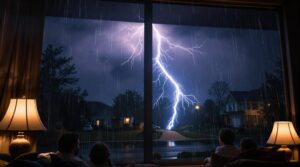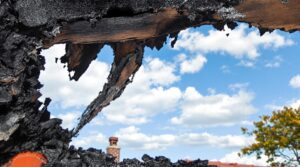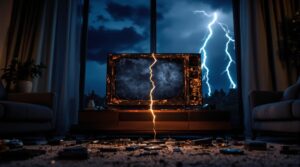When lightning strikes a house, extreme temperatures exceeding 50,000°F can cause severe damage to roofing materials and structures. Electrical surges may damage appliances, disrupt electrical systems, and create fire hazards. Homes lacking lightning protection face higher risks of fire and structural damage. Thorough assessments by licensed professionals are essential to identify visible and hidden damage. As the full effects of a lightning strike become apparent, it becomes clear that careful evaluation and action are necessary.
Key Takeaways
- A lightning strike can cause extreme temperatures exceeding 50,000°F, leading to fires, damage to roofing materials, and structural issues.
- Electrical surges from a lightning strike can damage appliances, disrupt electrical systems, and pose a risk of electrical shock.
- Homes without lightning protection systems are at higher risk of fire and structural damage from a lightning strike.
- A thorough assessment by a licensed professional is necessary to identify visible and hidden damage, including electrical system inspections.
- Homeowners insurance typically covers lightning strike damage, and prompt notification to the insurance company can aid in a smoother claims process.
Effects of a Lightning Strike on a House
A direct lightning strike to a house can have devastating consequences. The extreme temperatures generated by a lightning strike, exceeding 50,000°F, can ignite fires or cause severe damage to roofing materials and structures. Additionally, the electrical surge induced by the strike can damage appliances, disrupt electrical systems, and cause permanent failures in wiring. Homes without adequate lightning protection, such as lightning rods or surge protectors, face a markedly higher risk of fire and structural damage. Electrical damage can also occur due to the powerful surges, leading to smoke or burning odors within the home's systems. The installation of surge protectors and lightning protection systems can help mitigate the effects of lightning strikes and prevent electrical damage, reducing the risk of fire and ensuring the safety of the electrical systems.
Assessing the Damage After a Lightning Strike
Most homes that have been struck by lightning will require a thorough assessment to identify the full extent of the damage. The examination should focus on both visible and hidden signs of destruction, including scorch marks, smoke marks, and cracks in roofing materials. Electrical systems also necessitate a detailed electrical inspection by a licensed electrician to assess damage from potential power surges. This assessment will provide vital evidence for insurance claims, which typically cover lightning damage. In the event of significant damage or fire hazards, homeowners should contact their insurance company and local fire department to report the incident. Documenting all damage and unusual electrical issues will guarantee that the assessment is accurate and support any subsequent claims related to the lightning-struck home. Effective claim documentation submission, including photos and repair estimates, is crucial for receiving proper compensation from your insurance provider.
Safety Precautions to Take Immediately After a Strike
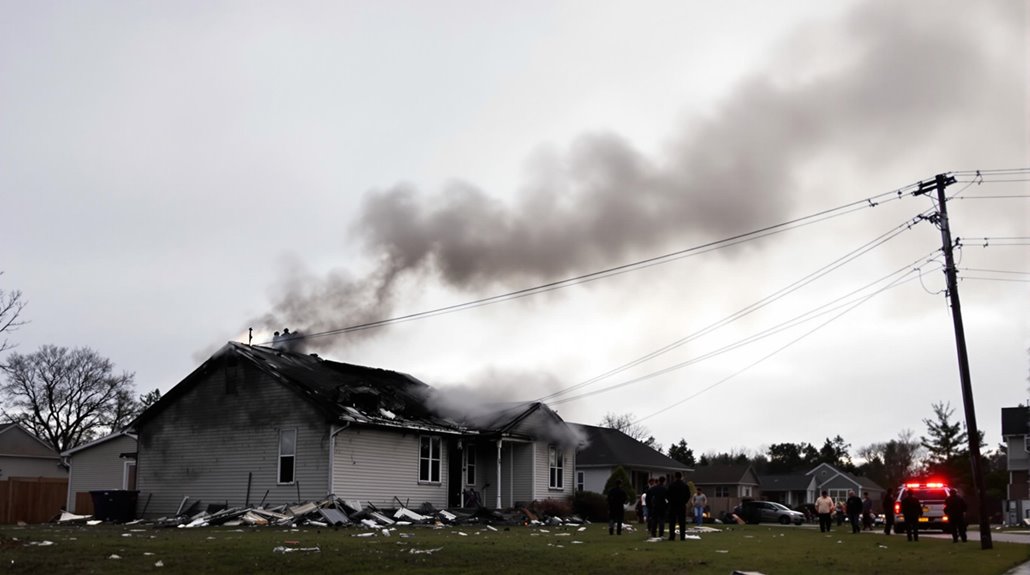
Following a lightning strike, it is vital to prioritize safety above all else, as the potential for fire hazards and electrical shocks is greatly heightened. Immediately inspect the building for visible signs of lightning damage, paying close attention to the roof and electrical outlets for cracks and burn marks. Check for hidden fires, particularly in attics or walls, and evacuate the premises, calling 911 to notify the fire department if smoke is detected. Unplug electronic devices to prevent damage from electrical surges. Call an electrician to conduct a thorough inspection of the electrical system, identifying potential hazards or needed repairs. Document all damage meticulously for insurance purposes, as most policies cover lightning-related damages. Promptly taking these precautions helps guarantee a safe and efficient recovery process.
Understanding the Impact on Electrical Systems
A direct or indirect lightning strike can lead to severe electrical system damage, including blown fuses, tripped circuit breakers, and melted wiring. Evaluating this damage is essential to guarantee household safety and identify areas requiring immediate repair or replacement. Effective evaluation and prevention strategies, such as the installation of whole-house surge protectors, can mitigate the impact of power surges on sensitive electronics and electrical infrastructure.
Assessing Electrical Damage
When lightning strikes a house, the electrical damage that ensues can be extensive and potentially catastrophic, compromising the integrity of the home's wiring system and destroying appliances due to power surges. Direct lightning strikes can cause temperatures to exceed 50,000°F, melting or vaporizing electrical components and wiring. Shockwaves can also cause cracks in structures, affecting embedded electrical wiring. To assess damage to the electrical system, it is crucial to conduct thorough inspections post-strike. A trustworthy electrician can perform a Megger test to evaluate the insulation conditions in the electrical system. Values below two indicate potential faults requiring immediate repair. By taking swift action, homeowners can prevent future damage and guarantee the electrical wiring in their house remains safe and functional.
Preventing Power Surges
Because power surges resulting from lightning strikes can irreparably damage electrical components, understanding the causes and prevention strategies is essential for safeguarding a house's electrical system. One measure to protect your home is by installing whole-house surge protectors, which provide a barrier against excess voltage caused by lightning strikes. Regular inspections of GFCI receptacles and other electrical systems also help identify vulnerabilities that could be exacerbated by lightning-induced surges. Additionally, licensed electricians can perform tests, such as Megger tests, to check the integrity of electrical insulation. Moreover, unplugging devices before a storm is a simple and free precaution to prevent damage from power surges. By implementing these measures, homeowners can effectively shield their homes from the devastating effects of lightning-induced power surges.
Mitigating Damage and Preventing Future Strikes
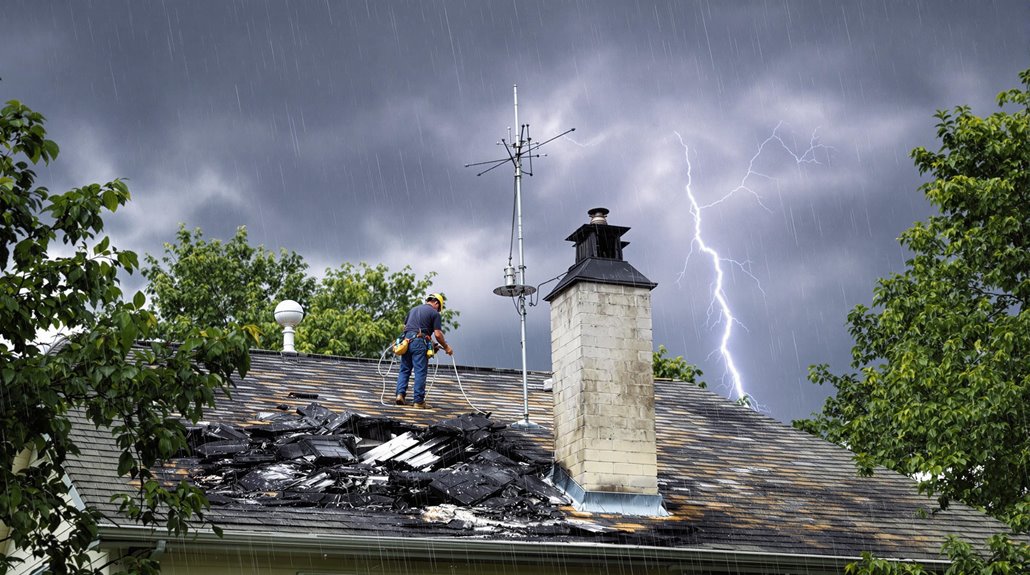
Following a lightning strike, a thorough assessment is essential to determine the extent of damage to a house's electrical system, structure, and contents. Effective mitigation strategies can then be implemented to prevent future strikes, including the installation of lightning rod systems that direct electrical discharges harmlessly into the ground. By adopting a proactive approach, homeowners can greatly reduce the risk of lightning-related damage and guarantee a safer living environment.
Assessing Lightning Strike Damage
In the aftermath of a lightning strike, a thorough evaluation of the damage is vital to determine the extent of the destruction and prevent further hazards. A detailed inspection of the property should focus on the roof, electrical systems, and visible signs of damage such as smoke marks or cracks in structures. Electrical systems, in particular, require careful scrutiny, as hidden damage can lead to fires or future system failures. Trained professionals should inspect the premises to identify potential risks and recommend necessary repairs or replacements. Documentation of all damage is important to support insurance claims. By evaluating the damage and taking proactive measures, homeowners can mitigate the impact of a lightning strike and maintain the integrity of their electrical systems. Surge protectors can also be installed to prevent future damage.
Protecting Against Future Strikes
Homeowners who have experienced a lightning strike understand the importance of taking proactive measures to prevent future damage. Protecting against future strikes requires a thorough approach that involves multiple components.
- Regular Electrical Inspections: Licensed electricians can identify potential vulnerabilities in the electrical system, ensuring it can withstand lightning strikes.
- Whole-House Surge Protectors: Installing surge protectors can prevent voltage surges, safeguarding sensitive electronic devices and appliances.
- Maintaining Structural Integrity: Keeping roofs, windows, and chimneys in good condition can minimize structural damage from shock waves caused by nearby lightning strikes.
- Lightning Rod System: Installing a lightning rod system can redirect electrical discharge safely into the ground, reducing the risk of damage by up to 99% when properly installed by professionals.
Installing Lightning Rod Systems
Because lightning strikes can cause catastrophic damage to homes, installing a lightning rod system is an important step in mitigating damage and preventing future strikes. A complete lightning protection system includes rods, surge protectors, and gas piping protection, which can be up to 99% effective in preventing damage. Professional installation by recognized organizations is vital to guarantee compliance with safety standards and effectiveness. Regular inspections and maintenance of lightning protection systems are also important to confirm they function correctly and continue to provide protection over time. By installing a lightning rod system, homeowners can markedly reduce the risk of fire and structural damage, potentially lowering insurance premiums. Effective lightning rod systems provide reliable protection, safeguarding homes and their occupants from the devastating effects of lightning strikes.
Insurance Coverage and Claims Process
While lightning strikes are unpredictable and uncontrollable natural events, the impact of such an event on a home can be mitigated through insurance coverage specifically designed to address damage caused by lightning. Homeowners insurance typically covers damage caused by lightning strikes, including fire damage, structural damage, and electrical system issues. To navigate the claims process effectively, homeowners should follow these steps:
- Promptly notify the insurance company: Informing the insurance provider in a timely manner allows for a smoother claims process and quicker assistance.
- Document all visible damage: Thoroughly record all damage using photographs and written descriptions to support the insurance claim.
- Review policy details: Understand coverage limits and exclusions related to lightning damage.
- Keep records of repairs and maintenance: Maintain documentation of property upkeep to aid in substantiating claims and expediting the recovery process.
Understanding your replacement cost value is crucial when filing a claim, as this determines the compensation you'll receive for lightning-related damages.
Hiring a Professional for Repairs and Inspections

Following a lightning strike, it is vital to engage the services of licensed professionals to assess and address potential damage to a house. Hiring a licensed electrician guarantees thorough inspections are conducted to identify hidden electrical damage, essential for preventing fire hazards. Professionals can perform specialized tests, such as Megger tests, to assess electrical insulation integrity and detect faulty wiring. Engaging experienced contractors for repairs assures that any structural damage, including to roofs and chimneys, is addressed promptly. This documentation from certified professionals is often required for insurance claims, highlighting the importance of hiring experts. By scheduling regular maintenance and inspections with qualified technicians, a home's resilience to future lightning strikes can be greatly improved, guaranteeing electrical systems are up to code and functioning properly. Public adjusters can help maximize insurance claim settlements by thoroughly documenting all structural and electrical damage from lightning strikes.




